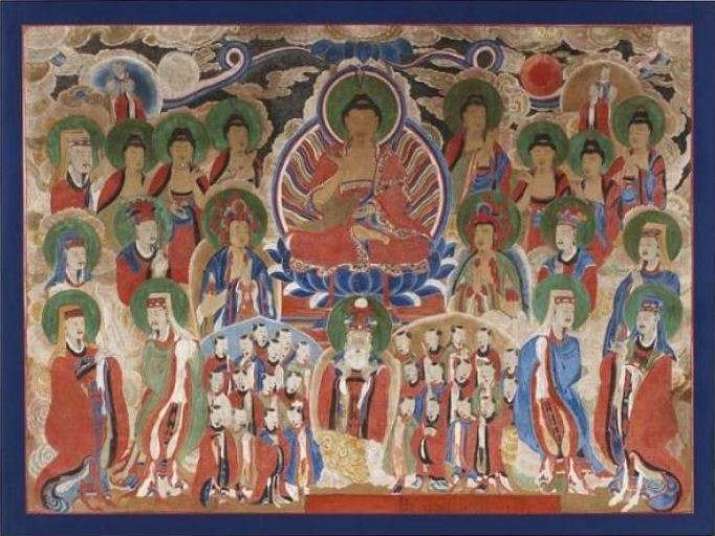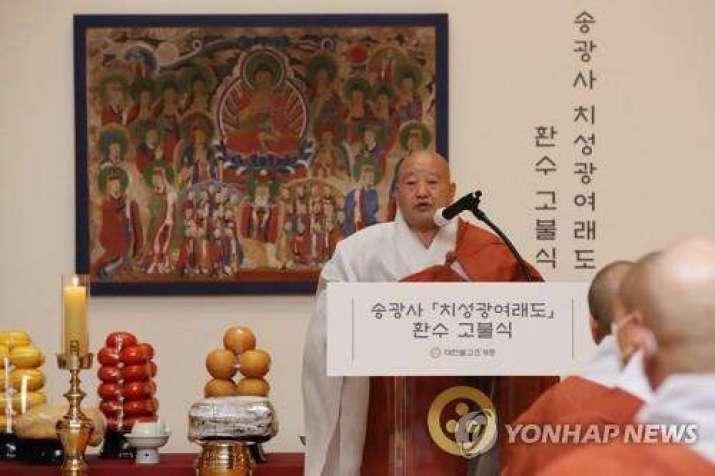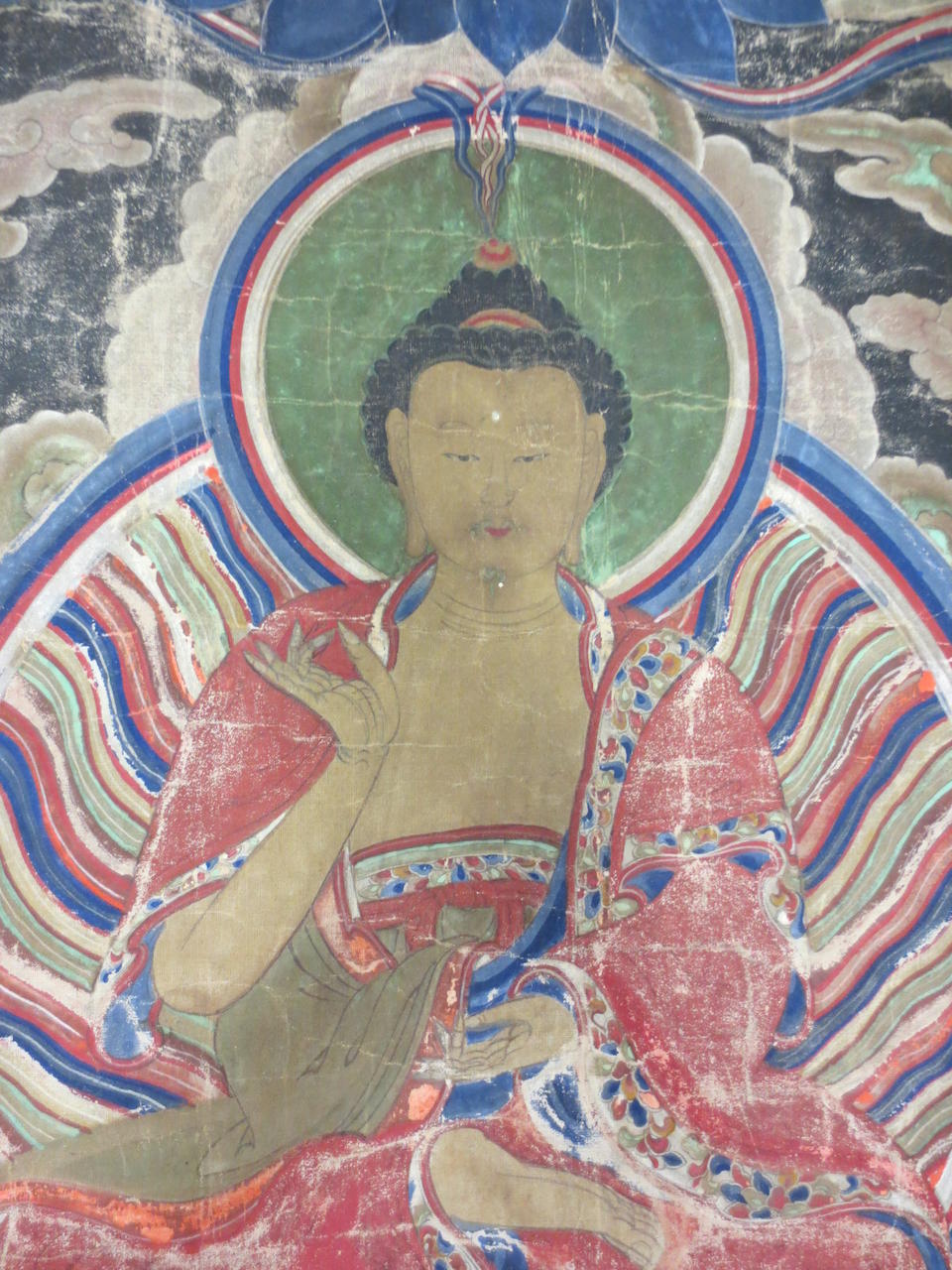NEWS
Rare 19th Century Buddhist Painting Returns to Korea from the UK
 The Assembly of Tejaprabha Buddha, 1898. From koreatimes.co.kr
The Assembly of Tejaprabha Buddha, 1898. From koreatimes.co.krA rare Buddhist painting dated to the 19th century, and believed to have been removed from Korea during the 1950–53 Korean War, has found its way back to its country of origin from Britain, the Jogye Order of Korean Buddhism, South Korea’s largest Buddhist order, has revealed.
The silk painting, titled The Assembly of Tejaprabha Buddha (also known as the North Star Buddha and the Buddha of Blazing Light), has been dated to 1898 and is believed to have originally been commissioned for Songgwang-sa, a renowned Seon (Zen) Buddhist temple in the mountains of southwestern Korea. Measuring 141 by 102 centimeters, the painting depicts the Buddha as a radiant seated figure flanked by the bodhisattvas of the Sun and the Moon, seven buddhas, and a host of celestial deities.
A note attached to the bottom of the painting is reported to indicated that the work was painted by two Buddhist monks named Hyanghomyoyeong and Yongseoncheonhui, who are known to have produced many paintings for the temples Songgwang-sa and Seonam-sa in the late 19th century, during Korea’s Joseon dynasty.
 Ven. Wonhaeng, president of the Jogye Order, speaks during a ceremony at the Memorial Hall of Korean Buddhist History and Culture on 23 July to mark the return of The Assembly of Tejaprabha Buddha. From yna.co.kr
Ven. Wonhaeng, president of the Jogye Order, speaks during a ceremony at the Memorial Hall of Korean Buddhist History and Culture on 23 July to mark the return of The Assembly of Tejaprabha Buddha. From yna.co.krTracing its origins back to 867, during Korea’s Silla dynasty (57 BCE–935 CE), Songgwang-sa (Piney Expanse Monastery) is one of the three principal Buddhist temples in Korea, each of which represents one of the Triple Gems of Buddhism—the Buddha, the Dharma, and the Sangha. Located on Mount Songgwangsan in South Jeolla Province, Songgwang-sa is one of the oldest Seon temples in Korea and has been rebuilt and restored many times over the centuries.
The Jogye Order said on 23 July that The Assembly of Tejaprabha Buddha had been repatriated with the help of the Overseas Korean Cultural Heritage Foundation and Songgwang-sa, adding that a ceremony had been held at the Memorial Hall of Korean Buddhist History and Culture in Seoul to mark the return of the rare work of art. The Jogye Order noted that the painting had arrived in Korea from the UK on 28 June after discussions with the owner, and would be returned to Songgwang-sa.
The Jogye Order is a school of Seon (Zen) Buddhism that traces its roots back some 1,200 years to the Unified Silla (also known as the Later Silla) kingdom (668–935). The Jogye school as a distinct entity emerged in the late 11th century when the monk Bojo Jinul, credited as the school’s founder, sought to combine Seon practices with the theological underpinnings of sutra-based Buddhist schools, including Korean Pure Land Buddhism. The order now represents the largest segment of South Korea’s Buddhist population, administering some 1,900 active temples, more than 13,000 monastics, and seven million lay followers nationwide.

The Assembly of Tejaprabha Buddha, detail. From bonhams.com
The Overseas Korean Cultural Heritage Foundation is reported to have come across The Assembly of Tejaprabha Buddha at an auction, while searching for missing cultural assets.
Established in 2012 as an affiliate of the governmental Cultural Heritage Administration, the foundation is tasked with locating and retrieving appropriated Korean cultural heritage. The Overseas Korean Cultural Heritage Foundation is reported to have tracked down more than 193,000 cultural properties in 21 countries as of April this year, of which 42 per cent are in Japan, 27.5 per cent in the US, 6.7 per cent in China, 6.3 per cent in Germany, and 4 per cent in the UK.
“Not all Korean cultural assets overseas were taken out illegally,” a foundation official observed. “Some were gifts or exported at the time of production. We try to recover those that have been smuggled out or . . . that were looted, and purchase those of high historical or artistic value so they can be preserved here in Korea and research can be carried out on them.” (The Korea Times)
According to census data for 2015, the majority of South Korea’s population—56.1 per cent—holds no religious affiliation. Christians make up the largest religious segment of the population at 27.6 per cent, while Buddhists account for 15.5 per cent.
See more
19th-century Buddhist painting returned from Britain (Yonhap News Agency)
19th-century Buddhist painting returned from Britain (The Korea Times)
Korea ramps up efforts to bring back looted treasures (The Korea Times)
‘The North Star Buddhist’ returns to Songgwang Temple from U.K. (The Dong-a Ilbo)
19th-century Buddhist Painting Returned from Britain (The Korea Bizwire)
Related news from Buddhistdoor Global
National Museum of Korea Reopens with Extensive Exhibitions, Including Buddhist Treasures
LACMA Returns Four Looted Buddhist Paintings to Korea
Ven. Pomnyun Sunim Plans Live-streamed Global Dharma Talk
Korean Buddhists Join Fellow Religious Leaders to Call for Ban on Discrimination Against Minorities
Head of the Jogye Order of Korean Buddhism Blames Greed, Avarice for COVID-19 Pandemic
Related features from Buddhistdoor Global
Engaged Buddhism: Seon Master Pomnyun Sunim Pledges 10,000 Tons of Food Aid for Children in North Korea
From Seoul to Somerville: The Founding of a Korean Won Buddhist Temple in Massachusetts
Jungmyungsa Buddhist Temple: A Haven of Korean Buddhism in Queens
Seon and the City














